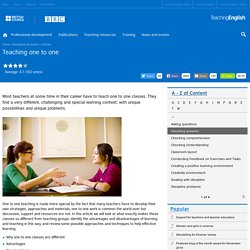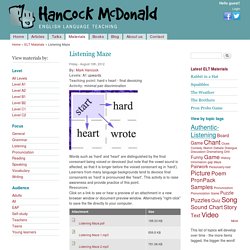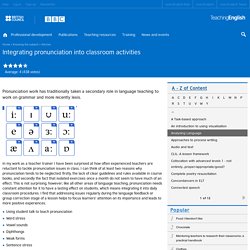

TeachingEnglish. TeachingEnglish. Make Videos and Presentations Online. TeachingEnglish. Teaching one to one. One to one teaching is made more special by the fact that many teachers have to develop their own strategies, approaches and materials; one to one work is common the world over but discussion, support and resources are not.

How to get started as an online teacher of English. Have you thought about teaching English online? Emma Segev gives some practical tips and useful websites for getting started in one of our top five articles of all time, illustrated by artist Jamie Johnson. When I first started teaching in 2004, I was sceptical about the effectiveness of online teaching, but since then I have accumulated a lot of experience. I'd like to share with you a few things I've learned along the way. Getting started Contrary to popular opinion, I recommend starting your online teaching career by working for an established company. When choosing an established company, you'll need to find one that has students looking for lessons in your working hours (your time zone). Creating a blog In the last few years, I've created more of my own materials, usually on the back of envelopes, in notebooks, word files and on scraps of paper.
Grouping students. Do you think about whether you’ve got a balance between pairs, groups, whole class and individual work? If you have activities for pairs and groups, do you let the students decide who they’re going to work with or do you decide? This tip looks at the advantages and disadvantages of the three main ways of grouping students. They are, giving students the choice, random grouping and selecting the groups yourself. You’ll probably find that no one way will always be the best choice for a particular group, but that you’ll use all three ways at different times depending on your students and the activities you plan to do. Giving students the choiceThe chances are, if you let your students decide who they want to work with they will always stick to the same people. Paul Seligson, a well known TEFL author and teacher trainer, recently gave a workshop about classroom management at a conference here in Barcelona.
Managing: How to encourage and manage active involvement in group work. Working in pairs and groups. The advantages of pair work and small group work Gives learners more speaking time Changes the pace of the lesson Takes the spotlight off you and puts it onto the children Allows them to mix with everyone in the group Gives them a sense of achievement when reaching a team goal Teaches them how to lead and be led by someone other than the teacher Allows you to monitor, move around the class and really listen to the language they are producing Pitfalls and how to avoid them You could lose control of the class.
Set up a signal before you start, like a visual time out with your hands, so that they know when to stop. Error Correction 1. Therefore the aim of this article is not to be prescriptive, but to highlight some key areas.

It is in 2 parts. In the first part we look at ... Attitudes to error correction Categorising errors A model for correcting writing The role of planning Practical techniques / ideas for correcting writing. Vocabulary activities. The Pronunciation Blog - Adrian Underhill's Pronunciation Site. MR Tips for giving clear instructions. ML Error correction techniques. Free Archives. ML A menu of practice activities. Carol Read - The secret of working with children. Pron Journey hit v heat. Listening Maze. Words such as 'hard' and 'heart' are distinguished by the final consonant being voiced or devoiced (but note that the vowel sound is affected, so that it is longer before the voiced consonant eg in 'hard').

Learners from many language backgrounds tend to devoice final consonants so 'hard' is pronounced like 'heart'. This activity is to raise awareness and provide practice of this point. Resources: Click on a link to see or hear a preview of an attachment in a new browser window or document preview window. Alternatively "right-click" to save the file directly to your computer. Words such as 'hard' and 'heart' are distinguished by the final consonant being voiced or devoiced (but note that the vowel sound is affected, so that it is longer before the voiced consonant eg in 'hard').
Resources: English File Student's Site. BBC Learning English. Fun with Pronunciation Drills! Now, I’m not suggesting that the infamous audio-lingual method should make its comeback – far from it!

Luckily, the days of de-contextualised, lesson-long, teacher-led chants are well and truly behind us (apart from the Callan method), but surely we can make some room for pronunciation drills? Many teachers today avoid drills at all costs! But I’ve actually become quite the superfan. What better way to get students familiar with new sounds, word stress, sentence stress, intonation, lexical chunks and connected speech, than with pronunciation drills. If you use short, snappy chunks of language throughout the lesson with creative drilling techniques as opposed to monotonous repetition, your students will really enjoy it. Forvo: the pronunciation dictionary. All the words in the world pronounced by native speakers. Integrating pronunciation into classroom activities. In my work as a teacher trainer I have been surprised at how often experienced teachers are reluctant to tackle pronunciation issues in class.

I can think of at least two reasons why pronunciation tends to be neglected: firstly, the lack of clear guidelines and rules available in course books, and secondly the fact that isolated exercises once a month do not seem to have much of an effect. This is not surprising, however; like all other areas of language teaching, pronunciation needs constant attention for it to have a lasting effect on students, which means integrating it into daily classroom procedures. I find that addressing issues regularly during the language feedback or group correction stage of a lesson helps to focus learners' attention on its importance and leads to more positive experiences. Using student talk to teach pronunciationWord stressVowel soundsDiphthongsWeak formsSentence stressConclusion After the activity, on the board I draw a column with the heading /e/.
MR checking understanding. ML Introducing new language.